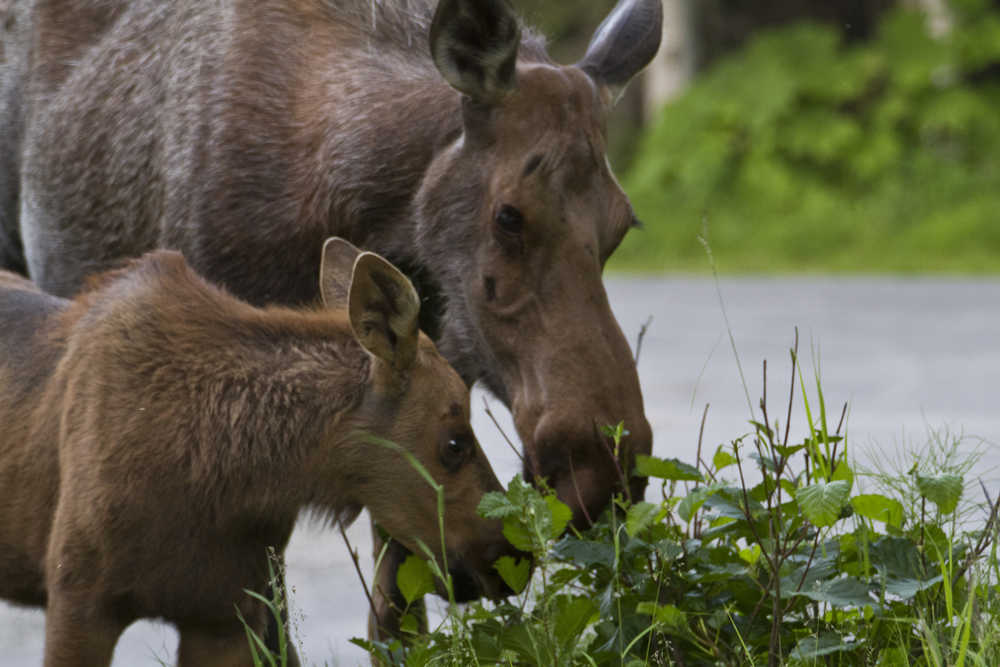“Hurumph!” This is a sound you never want to hear from the woods when you are walking along a trail. This guttural bellow followed by crashing of underbrush is not what you want to hear when you are alone on a trail and have been watching your footing on the ice instead of being alert to your surroundings. Those two sounds getting closer to you in the brief few seconds between a calm pulse and the rush of adrenaline that makes your eyes go wide and your palms sweat is the last thing you want to notice when you are alone, on an icy trail, carrying nothing but a pen and notebook on the way to a meeting…but they were my reality late last week.
When do you start thinking about wildlife safety? I took note this month as reports of bears awake on the Kenai Peninsula started coming into the office here at Kenai National Wildlife Refuge. I listened up again when new signage on this subject was reviewed for an audio narration project at the new Visitor Center. But on a calm, warm Thursday afternoon within sight of my car and walking between two buildings I spend most of the work week inside, I had let my guard down. I had walked right by a moose and her baby grazing along the forest edge. I am glad I have trained to respond in this dangerous situation with appropriate action.
As soon as I saw baby flushing towards me in a panic, with mom some yards behind, I found firmer footing in the snowbank and lifted my arms. “Hey moose!” I called out, stepping backwards into the alders as far as the ice and brush would allow. “Hi there, it’s just me. I didn’t see you. What a good mom you are. Hey there, moose.” It’s comical thinking back to my one-sided conversation. It seemed to work, though, identifying myself as human, setting the tone as calm but firm, and I didn’t stop talking and holding my hands high over my head until both moose had turned, retreating, with calmer gaits. Mother moose stopped to urinate. At the time I thought that was odd.
Later, recounting the event with Refuge biologists, I found out that it is a sign of fear. I also discovered that the negative reaction of mother moose to my non-threatening slow walk down a regularly traveled driveway could have signaled another threat in the area which had set her on guard. Could it have been a bear she had smelled that day? Did another person just chase her off from another part of the trail system? Did I just startle her by walking too near her baby when I wasn’t paying attention? I will never know what impelled her to bluff charge instead of lazily watch me from the woods as she has all winter (she and her yearling calf are regulars on Ski Hill Road) but I am grateful the reading and thought I had put in earlier was there when I needed it.
It wasn’t more than a minute before both mother and baby were heading away into the forest and over a hill, with just a backwards glance from baby ending our encounter. I kept an eye on these moose, now off in the distance, as I recovered my discarded notepad from the snow berm, thankful we had parted ways after just some warning words and my retreat. I was also glad only she had peed her pants!
Mothers of any species are protective. A mother moose caught off guard with a baby straying too close to a surprising human? She is on high alert. I learned how quickly she can go on the defensive during our brief encounter on that icy trail. Later this spring, mother moose will be welcoming their newborns to the world. Shaky on their spindly legs, these babies keep close to their moms, who are ever watchful for danger, perceived or real. It’s a season we humans also venture outdoors after long icy winters and this can mean the potential to meet these pairs on area roads and trails.
Please take a moment this spring to review safe wildlife practices, discuss and practice them with your family, and set up a safe walking plan with your kids so they are prepared if they encounter a moose or bear outside. The Kenai Refuge Reflections Visitor Guide offers some quick safety guidelines for bears and moose on page 5, (available at http://1.usa.gov/1Gow2ca). Here are the basics when you encounter a moose:
• Move away! Maintain at least 75 feet between you and a moose.
• Watch for body language —if the moose lowers its head and ears, and the hair on its back and neck stands up, back off.
• If a moose charges, retreat behind a large tree or rock — most charges are bluffs and getting behind something solid offers important protection from their sharp, powerful hooves.
• Remember, keeping your distance from moose is the best way to avoid a negative encounter.
Find more helpful wildlife safety tips at the Alaska Public Lands Information Center website on both moose (http://www.alaskacenters.gov/traveling-in-moose-country.cfm) and bears (http://www.alaskacenters.gov/bear-safety.cfm).
Leah Eskelin is a Visitor Services Park Ranger at the Kenai National Wildlife Refuge. Find out more about the Refuge events by visiting http://www.fws.gov/refuge/kenai/ or by liking us on Facebook.

